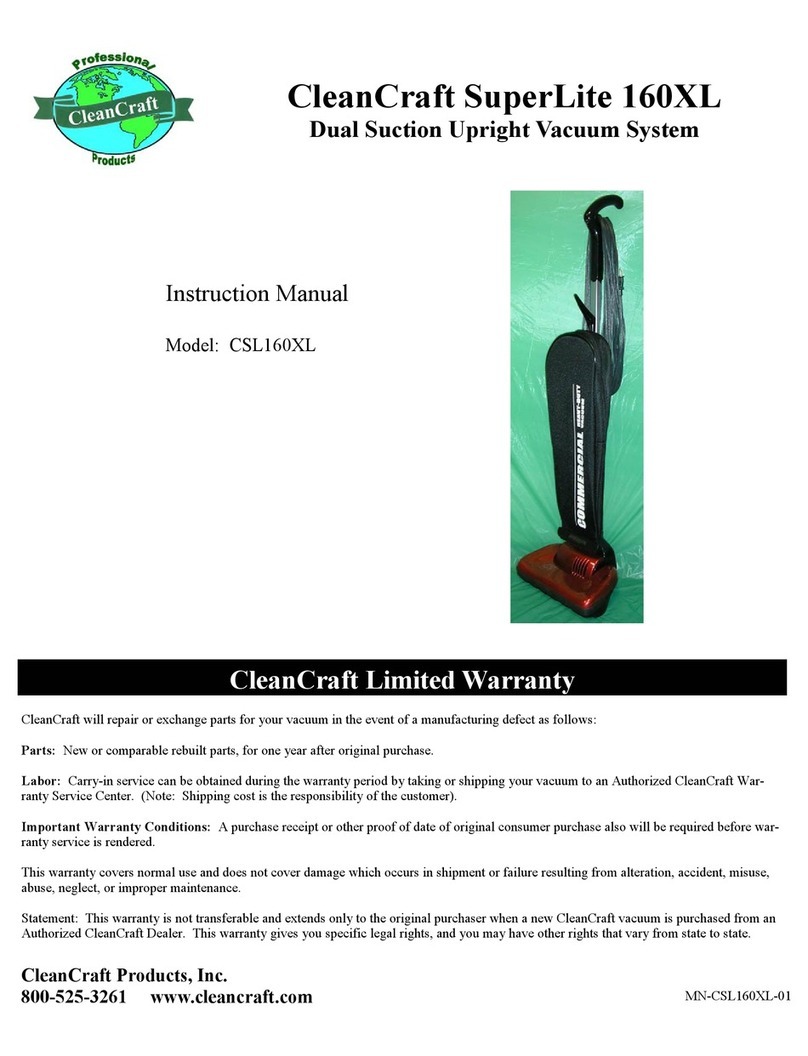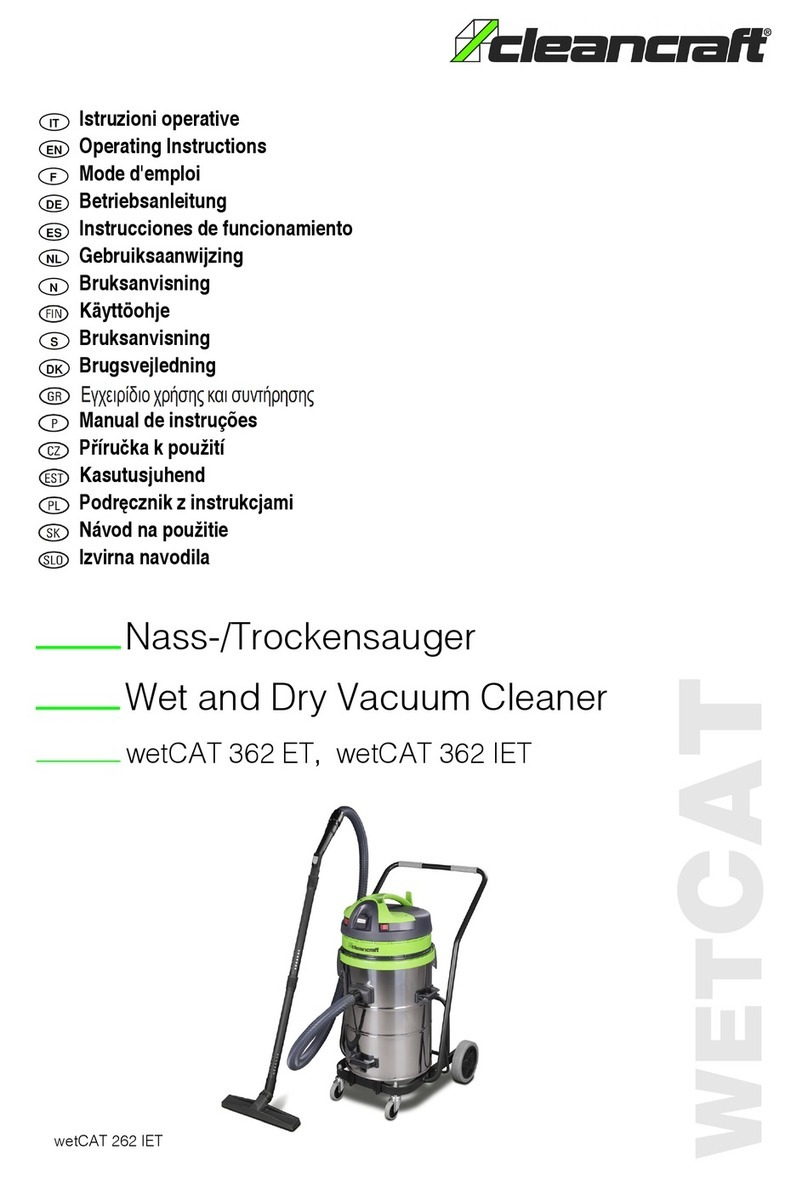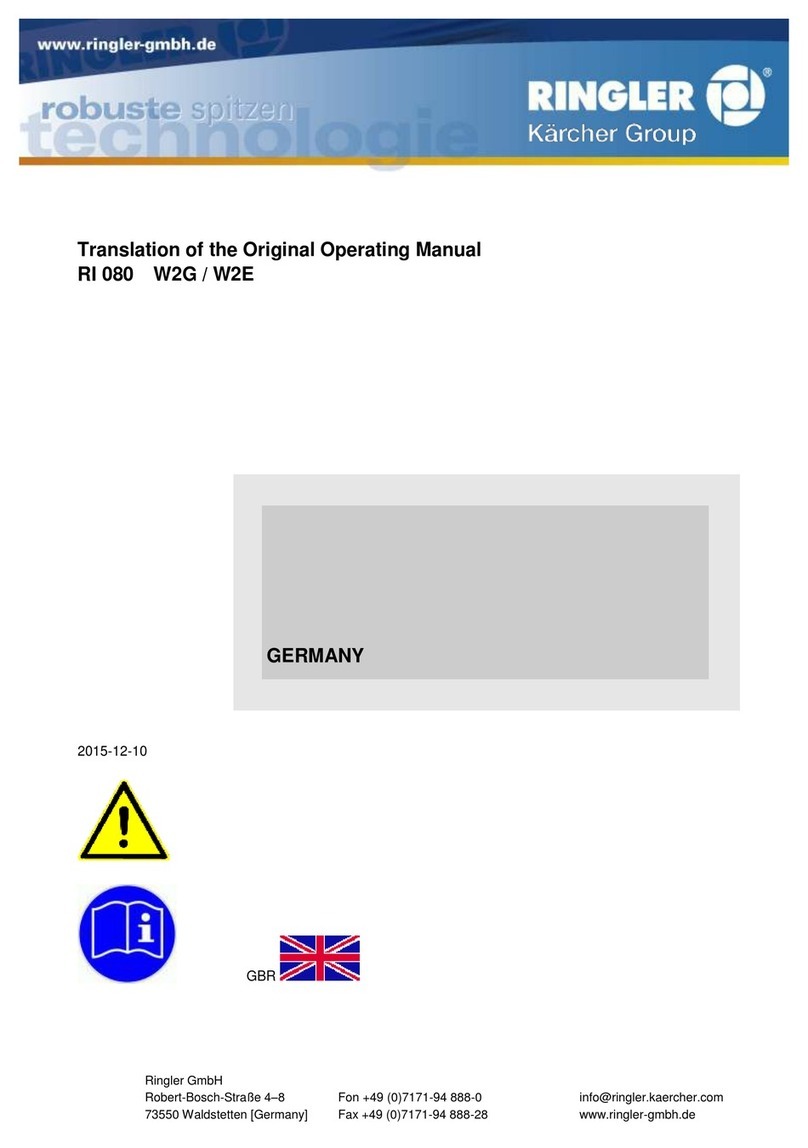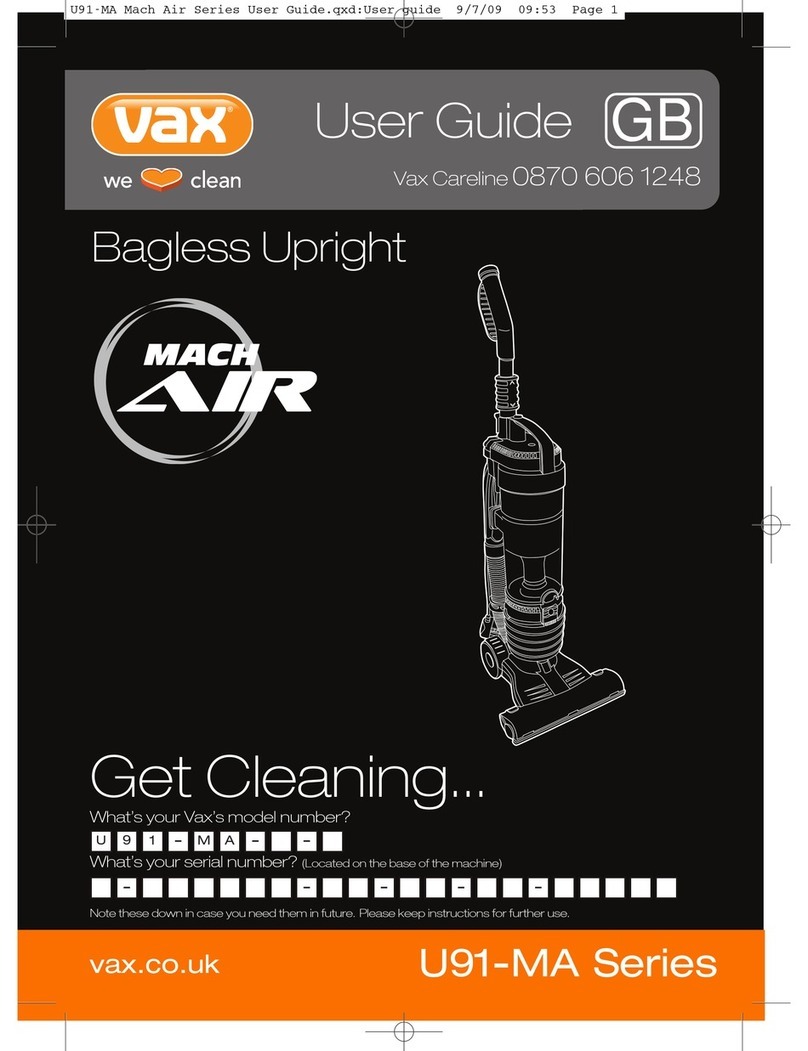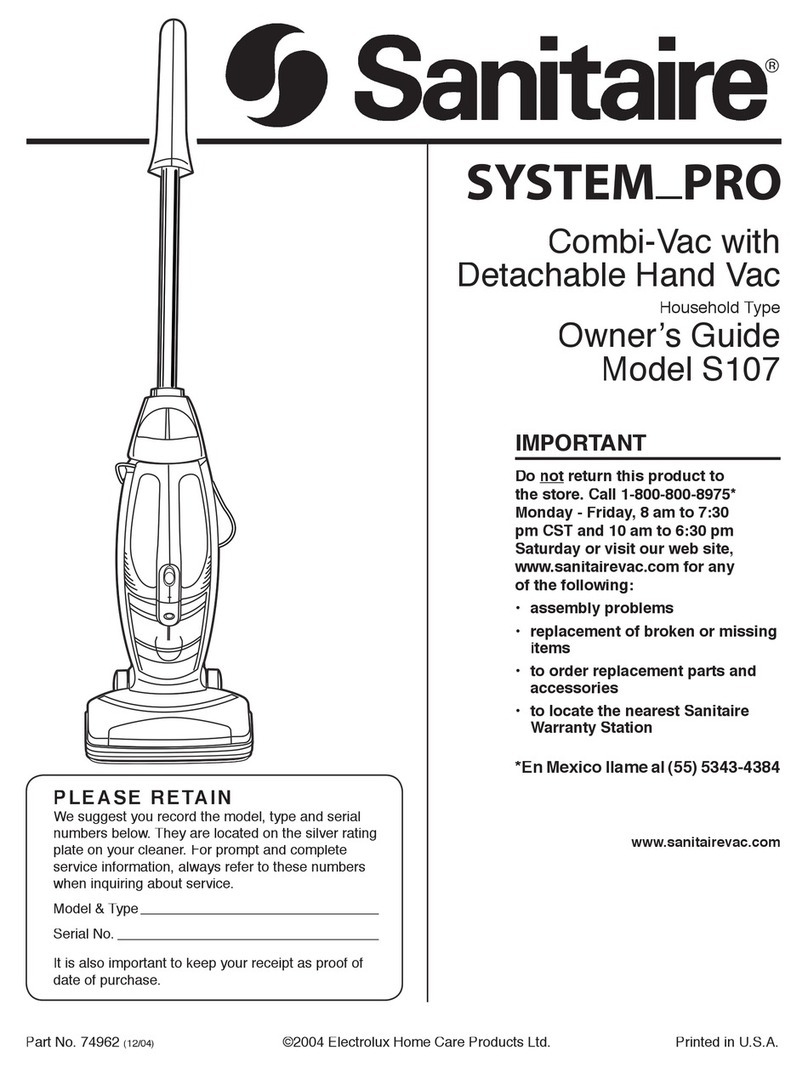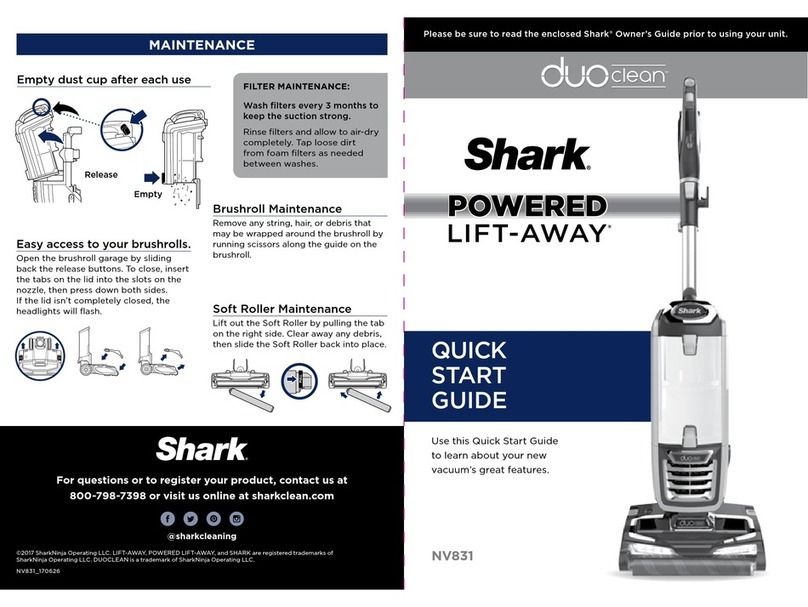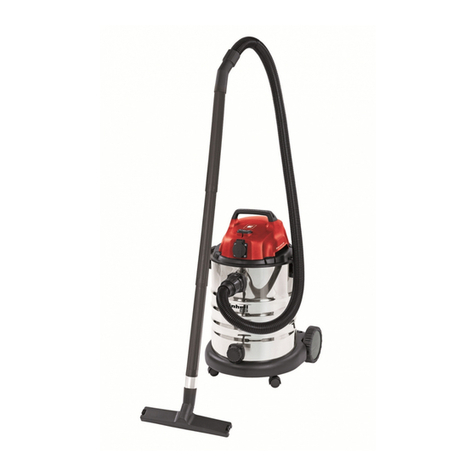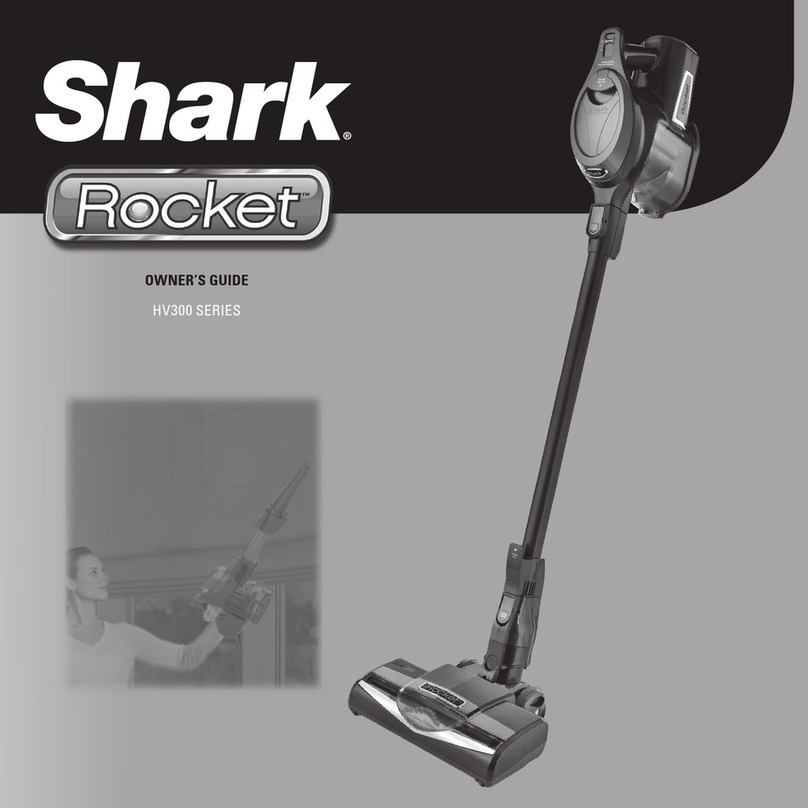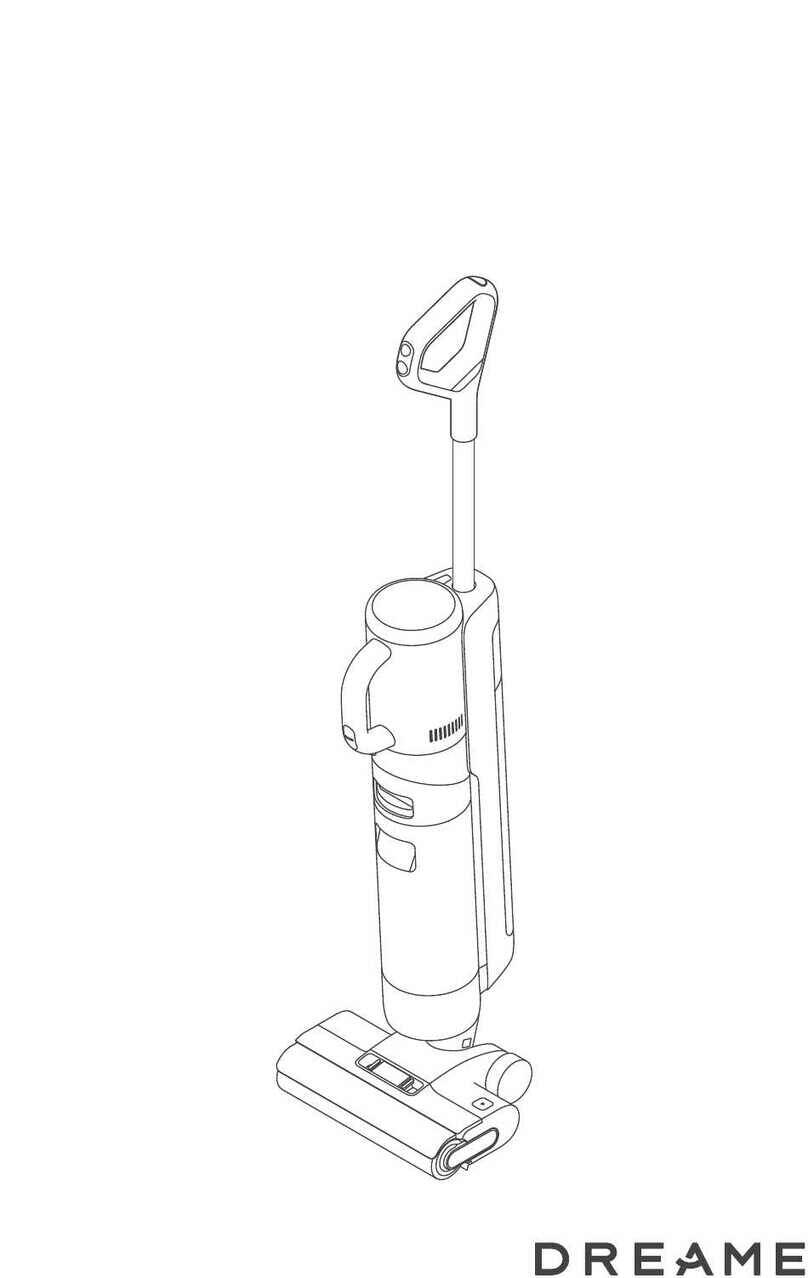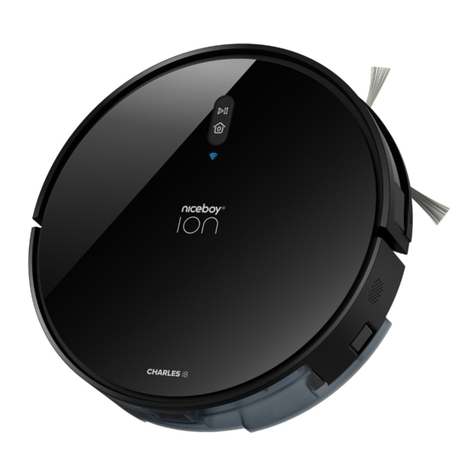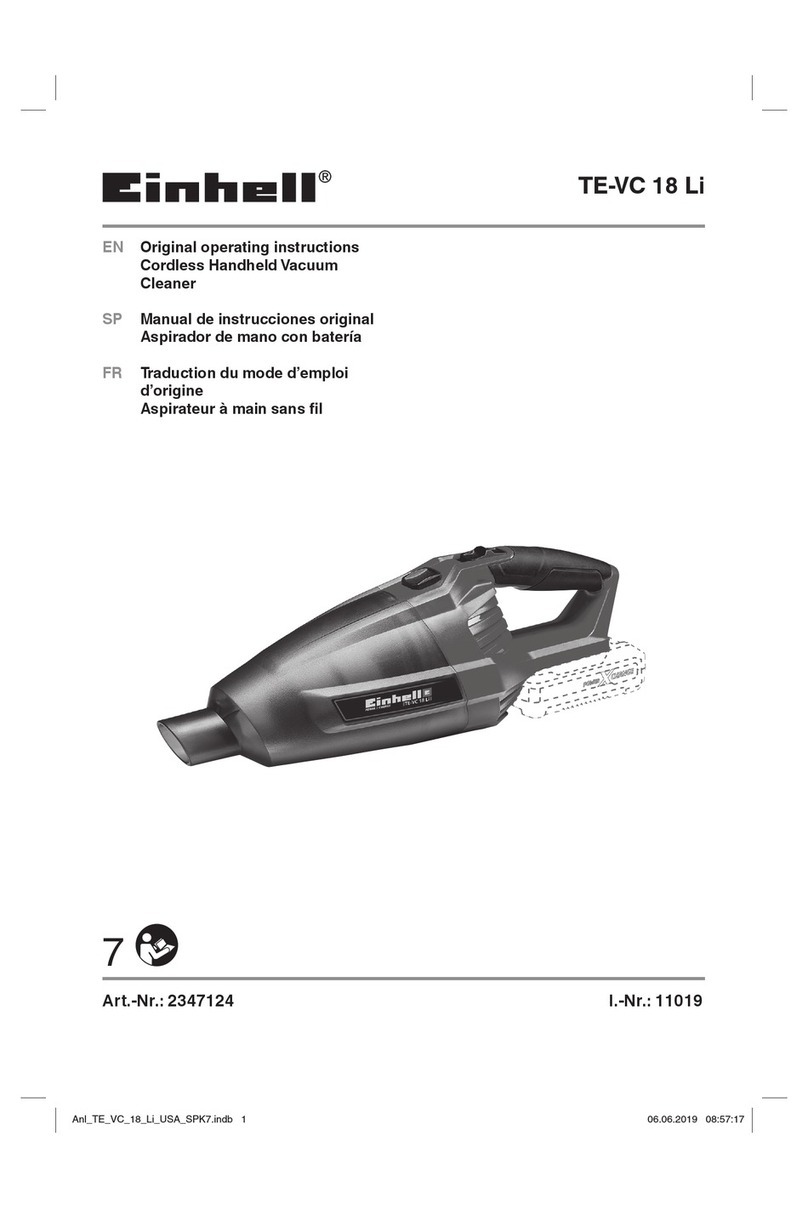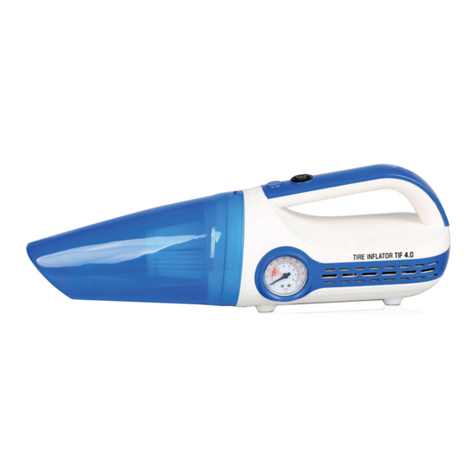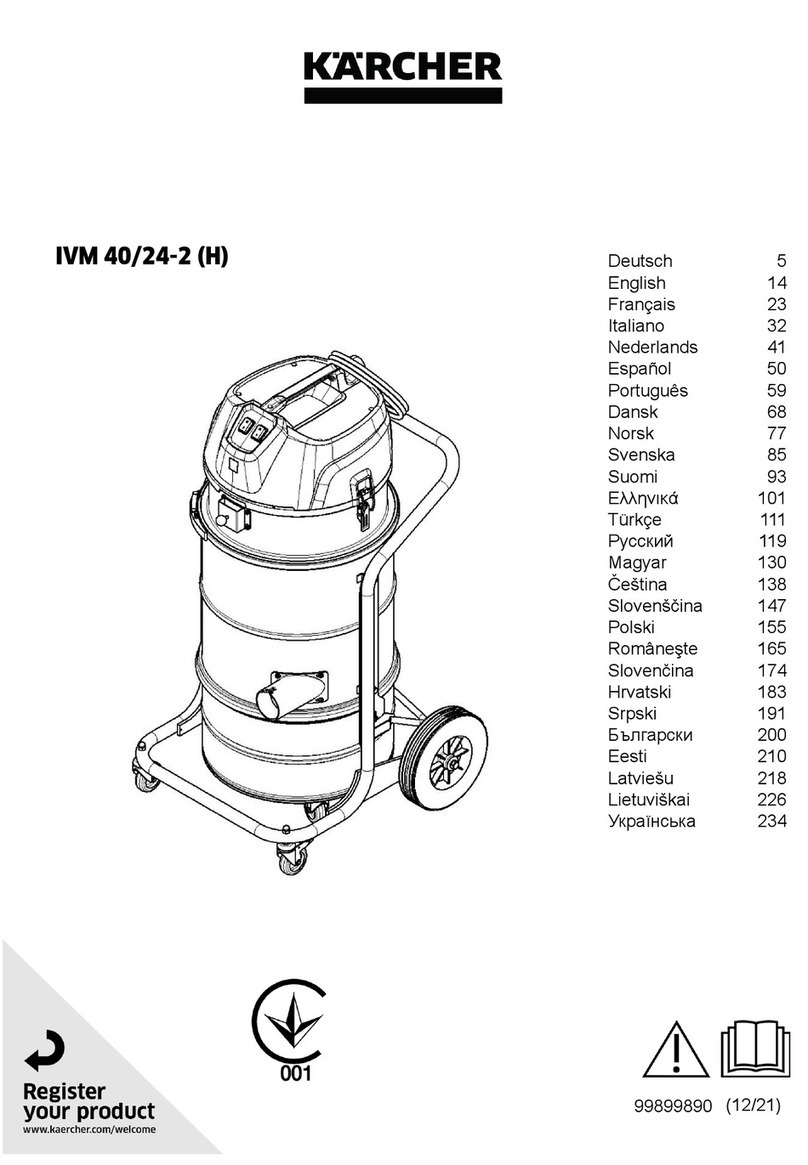CleanCraft dryCAT 16 L - Class User manual

DRYCAT-SERIES
Dry Vacuum Cleaner
Instruction Manual
dryCAT 16 L - Class
dryCAT 16 L - Class

2 dryCAT-Series | Version 1.02
Imprint
Product identification
Dry Vacuum Cleaner Item number
dryCAT 16 L - Class 002116
Manufacturer
Stuermer Maschinen GmbH
Dr.-Robert-Pfleger-Str. 26
D-96103 Hallstadt
Fax: 0049 (0) 951 96555 - 55
E-Mail: [email protected]
Internet: www.cleancraft.de
Indications regarding the operating instructions
Original Instructions
Publication: 29.03.2021
Version: 1.02
Language: English
Author: RL
Indications regarding the copyright
Copyright © 2021 Stürmer Maschinen GmbH, Hallstadt,
Germany.
The contents of these operating instructions are the sole
property of the company Stürmer.Passing on as well as
copying of this document, the use and distribution of its
content are prohibited if not explicitly permitted. Contra-
ventions are liable to compensation.
Subject to technical modifications and error.
Contents
1 Introduction .............................................................3
1.1 Copyright ............................................................ 3
1.2 Customer service................................................ 3
1.3 Limitation of liability............................................. 3
2 Safety........................................................................3
2.1 Symbol explanation ............................................ 3
2.2 Obligations of the operating company ................ 4
2.3 Requirements to staff.......................................... 4
2.4 Personal protective equipment ........................... 5
2.5 General safety regulations.................................. 5
2.6 Safety labels ....................................................... 6
3 Intended use ............................................................7
3.1 Misuse ................................................................
4 Technical Data .........................................................7
4.1 Type plate ..........................................................
5 Transport, pac aging, storage...............................8
5.1 Transport ............................................................ 8
5.2 Packaging........................................................... 8
5.3 Storage ............................................................... 8
6 Description of the device........................................8
6.1 Scope of delivery ................................................ 9
6.2 Accessories ........................................................ 9
7 Assembly .................................................................9
8 Operation ...............................................................10
8.1 Start and Stop................................................... 11
8.2 Operating instructions....................................... 11
8.2.1 Suction and blowing function....................... 11
8.2.2 Air regulation ............................................. 11
8.2.3 Filter cleaning system................................ 11
8.3 Seal inspection ................................................. 11
9 Care, maintenance and repair ..............................12
9.1 Care by cleaning............................................... 12
9.2 Maintenance and repair.................................... 12
9.3 Replacing the filter............................................ 12
9.3.1 Cleaning the filter ........................................ 12
10 Disposal, recycling of used devices..................13
10.1 Decommission ................................................ 13
10.2 Disposal of electrical equipment.................... 13
10.3 Disposal of lubricants...................................... 13
10.4 Disposal via municipal collection
points ..................................................................... 13
11 Troubleshooting ..................................................14
12 Spare parts drawing............................................15
12.1 Ordering spare parts...................................... 15
12.2 Spare parts drawing....................................... 16
13 Electrical circuit diagram....................................16
14 EC-Declaration of Conformity ............................17

Introduction
dryCAT-Series | Version 1.02 3
1 Introduction
You have made a good choice by purchasing the
CLEANCRAFT dry vacuum cleaner.
Read the operating manual thoroughly before com-
missioning the machine.
It gives you information about the proper commissio-
ning, intended use and safe and efficient operation and
maintenance of your dry vacuum cleaner.
The operating manual is part of the vacuum cleaner pac-
kage. Always keep this operating manual in the location
where your dry vacuum cleaner is being operated. All
local accident prevention regulations and general safety
instructions for the operating range of your va-cuum cle-
aner must also be complied with.
1.1 Copyright
The contents of these instructions are copyright. They
may be used in conjunction with the operation of the va-
cuum cleaner. Any application beyond those described
is not permitted without the written approval of Stürmer
Maschinen GmbH.
For the protection of our products, we shall register tra-
demark, patent and design rights, as this is possible in
individual cases. We strongly oppose any infringement
of our intellectual property.
1.2 Customer service
Please contact your dealer if you have questions con-
cerning your dry vacuum cleaner or if you need technical
advice. They will help you with specialist information and
expert advice.
Germany:
Stürmer Maschinen GmbH
Dr.-Robert-Pfleger-Str. 26
D-96103 Hallstadt
Repair service:
Fax: 0049 (0) 951 96555-111
E-Mail: [email protected]
Internet: www.cleancraft.de
Spare part orders:
Fax: 0049 (0) 951 96555-119
E-Mail: ersatz[email protected]
We are always interested in valuable experience and
knowledge gained from using the application which then
could be shared and be valuable to develop our products
even further.
1.3 Limitation of liability
All information and notes in these operating instructions
were summarised while taking applicable standards and
rules, the state-of-the-art technology and our long-term
knowledge and experiences into consideration.
In the following cases the manufacturer is not liable for
damages:
- Non-observance of the operating instructions,
- Inappropriate use
- Use of untrained staff,
- Unauthorised modifications
- Technical changes,
- Use of not allowed spare parts.
The actual scope of delivery may deviate from the ex-
planations and presentations described here in case of
special models, when using additional ordering options
or due to latest technical modifications.
The obligations agreed in the delivery contract, the gen-
eral terms and conditions as well as the delivery condi-ti-
ons of the manufacturer and the legal regulations at the
time of the conclusion of the contract are applicable.
2 Safety
This section provides an overview of all important safety
packages for the protection of operating personnel as
well as for safe and fault-free operation. Other task ba-
sed safety notes are included in the paragraphs of the in-
dividual phases of life.
2.1 Symbol explanation
Safety instructions
The safety notes in these operating instructions are high-
lighted by symbols. The safety notes are intro-duced by
signal words which express the concern of the risk.
D NGER!
This combination of symbol and signal words indi-
cates an imminently dangerous situation which may
lead to death or severe injury if not avoided.
W RNING!
This combination of symbol and signal words indi-
cates a potentially dangerous situation which may
lead to death or severe injury if not avoided.

4 dryCAT-Series | Version 1.02
Safety
Tips and recommendations
It is necessary to observe the safety notes written in
these operating instructions in order to reduce the risk of
personal injuries and damages to property.
2.2 Obligations of the operating company
The operating company is the person who operates the
vacuum cleaner for business or commercial reasons by
herself, or leaves it to a third party for use or application,
and who bears the legal product responsibility for the
protection of the user, the staff or for third parties.
Obligations of the operating company:
If the vacuum cleaner is used for commercial purposes,
the operating company of the vacuum cleaner must com-
ply with the legal working safety regulations. There-fore,
the safety notes in this operating manual, as well as the
safety, accident prevention and environment protec-tion
regulations applying for the area of application of the va-
cuum cleaner must be met. The following applies in parti-
cular:
During the entire lifetime the vacuum cleaner, the opera-
ting company must verify whether the opera-ting ma-
nuals prepared by her correspond to the current status of
the regulations, and must adapt these if necessary.
- The operating company must be informed about
the applying industrial safety regulations and fur-
ther analyse hazards resulting from the special
working conditions at the place of use of the vac-
uum cleaner. She must implement these in form of
operating manuals for the operation of the vacuum
cleaner.
- The operating company must unambiguously re-
gulate and determine the responsibilities for instal-
lation, operation, troubleshooting, maintenance
and cleaning.
- The operating company must ensure that all per-
sons who work with the vacuum cleaner, have read
and understood this manual. Furthermore she
must instruct the staff in regular intervals and in-
form them about the hazards.
- The operator must provide the necessary protec-
tive equipment to the staff and order the use of the
necessary protective equipment in a binding way.
Furthermore the operating company is responsible to
keep the vacuum cleaner always in a technically fla-
wless state. Thus, the following applies:
- The operator must ensure that the maintenance in-
tervals described in this manual are kept.
- The operator must have all safety devices chec-
ked regularly for their good working order and their
integrity.
2.3 Requirements to staff
The different tasks described in this manual represent
different requirements to the qualification of the persons
entrusted with these tasks.
C UTION!
This combination of symbol and signal words indi-
cates a potentially dangerous situation which may
lead to slight or minor injury if not avoided.
TTENTION!
This combination of symbol and signal words indi-
cates a possibly dangerous situation which may lead
to property and environmental damages if they are
not avoided.
NOTE!
This combination of symbol and signal words indi-cates
a potentially dangerous situation which may lead to
material or environmental damage if not avoided.
Tips and recommendations
This symbol highlights useful tips and recommenda-
tions as well as information for an efficient and trou-
ble-free operation.
W RNING!
Danger in case of insufficient quali-
fication of the staff!
Insufficiently qualified persons cannot estimate the
risks while using the vacuum cleaner and expose
themselves and others to the danger of severe or let-
hal injuries.
- Have all works only performed by qualified per-
sons.
- Keep insufficiently qualified persons out of the wor-
king area.

Safety
dryCAT-Series | Version 1.02 5
Only persons reliable working procedures can be ex-
pected from, are allowed to perform all works. Persons
the responsiveness of which is affected by e. g. drugs,
alcohol or medication, are not allowed to work with the
machine. The qualifications of the personnel for the diffe-
rent tasks are mentioned below:
Operator:
The operator is instructed by the operating company
about the assigned tasks and possible risks in case of
improper behaviour. Any tasks which need to be per-for-
med beyond the operation in the standard mode must
only be performed by the operator if it is indicated in
these instructions and if the operating company ex-pres-
sively commissioned the operator.
Electrically qualified person:
Electrically qualified person is due to their professional
training, knowledge and experience as well as knowl-
edge of the relevant standards and regulations, in a po-
sition to carry out work on the electrical systems and to
independently recognize and avoid possible dangers.
Qualified personnel:
Due to their professional training, knowledge and expe-
rience as well as their knowledge of relevant regulations
the specialist staff is able to perform the assigned tasks
and to recognise and avoid any possible dangers them-
selves.
Manufacturer:
Certain works may only be performed by specialist per-
sonnel of the manufacturer. Other personnel is not au-
thorized to perform these works. Please contact our cus-
tomer service for the execution of all arising work.
2.4 Personal protective equipment
The personal protective equipment serves to protect per-
sons against impairments of safety and health while wor-
king. The staff member has to wear personal protec-tive
equipment while performing different tasks on and with
the machine which are indicated in the individual para-
graphs of these instructions.
The personal protective equipment is explained in the
following paragraph:
2.5 General safety regulations
Please note the following:
- Use the protective devices and fasten them se-
curely. Never work without the guards and keep
them in working order.
- Do not change the design of the dry vacuum cleaner
and do not use it for purposes other than the opera-
tions foreseen by the manufacturer.
- Ensure that there is sufficient lighting.
- Never work under the influence of diseases that im-
pair concentration, overtiredness, drugs, alcohol or
medication.
- Keep children and persons not familiar with the dry
vacuum cleaner away from their working environ-
ment.
- The dry vacuum cleaner must not be used by per-
sons with reduced physical, sensory or mental ca-
pacity.
- Do not pull on the power cord to unplug it from the
wall outlet. Protect the cord from heat, oil and sharp
edges.
- Immediately eliminate malfunctions that affect
safety.
- Protect the dry vacuum cleaner from moisture (risk
of short circuit).
- Before each use, make sure that no parts are dam-
aged on the dry vacuum cleaner.
- Damaged parts must be replaced immediately to
avoid sources of danger.
- Do not overload the dry vacuum cleaner! It works
better and safer in the specified power range.
- The unit must be used, assembled, repaired and
transported on a stable and safe surface.
- Do not use this unit outdoors, in high humidity envi-
ronments, or at low temperatures.
- Do not vacuum dust without a filter.
- Do not vacuum flammable materials.
- Do not vacuum explosive materials.
- Do not use the unit to vacuum explosive or flamma-
ble gases, liquids and dust particles, undiluted,
strong acids and alkalis, metal dust particles (such
as aluminum, magnesium, zinc) in combination with
strong alkaline or acid cleaning agents .
- Do not vacuum substances that can cause explo-
sions when in contact with air.
- Do not exceed the max. filling level of the container
- Do not use the vacuum cleaner in areas with tem-
peratures above 40 ° C.
- Do not vacuum glowing objects.
- Never open the tank during operation.
Protective gloves
The protective gloves serve to protect the hands
against sharp components as well as against fric-
tion, abrasions or deep injuries.
Safety boots
Safety boots protect the feet from being crushed, fal-
ling parts and slipping over on slippery ground.
Protective clothes
Protective clothes are made of a tightly fitted fabric
without the protruding parts of low tear strength.

6 dryCAT-Series | Version 1.02
Safety
- Do not immerse the device in water and do not use
water jets to clean it.
- Never pull the power plug or the suction hose.
- Do not use compressed air to clean the dry vacuum
cleaner.
- Use only original spare parts and accessories to
avoid possible hazards and risks of accidents.
- Do not suck in any materials that could damage the
filter elements (e.g. glass).
- Make sure that the values indicated on the motor
block correspond to those of the mains voltage to
which you wish to connect the unit.
- When using extension cables, make sure that they
are compatible with the power cable (larger or equiv-
alent cross-section) and that they do not come into
contact with liquids or conductive surfaces.
2.6 Safety labels
The following safety labels and instructions are attached
to the vacuum cleaner (Fig. 1) and must be observed.
Fig. 1: Safety labels
If safety labels on the machine are damaged or missing,
this can cause errors, personal injury and material dam-
age. The safety symbols attached to the machine must
not be removed. Damaged safety symbols must be re-
placed immediately.
As soon as the signs are not clearly visible and compre-
hensible at first glance, the machine must be stopped
until new signs have been attached.
D NGER!
Check the power cord regularly for damage, cracks or
aging (hairline cracks). If necessary, replace the
cable before use.
D NGER!
Always unplug the appliance before performing any
work, especially when the appliance is unattended or
in the presence of children.
D NGER!
Never point the suction opening at sensitive body
parts - of humans as well as animals - such as eyes,
ears, mouth ect.
D NGER!
Store the device on a firm, level surface and only in a
closed room without humidity.
D NGER!
Only use the accessories supplied with the device or
accessories that are precisely specified in the
instructions. The use of other brushes may compro-
mise safety.
D NGER!
Never leave the running dry vacuum cleaner unatten-
ded. Always disconnect the mains plug from the soc-
ket when the dry vacuum cleaner is not in use and
keep it out of reach of children or unauthorized per-
sons.
D NGER!
In the event of the unit tipping over, it is recommen-
ded to upright again before switching off.
D NGER!
The device is not suitable for environments that are
are protected against electrostatic discharges.
D NGER!
This vacuum cleaner is equipped with built-in thermal
overload protection to protect the motor from high
temperatures. This may occur during heavy use. If
the motor shuts down during operation, turn off the
switch and allow the motor to cool for 15-30 minutes.
Turn on the dry vacuum and resume operation.

Intended use
dryCAT-Series | Version 1.02
3 Intended use
The dry vacuum cleaner is designed exclusively for vacuu-
ming dust and dirt, but not for wet vacuuming. The device is
suitable for use in public buildings such as hotels, schools,
factories, offices and stores.
The unit is suitable for the following applications:
Vacuuming dry, non-flammable dusts, wood chips and ha-
zardous dusts with exposure limits > 1 mg/m³ (dust class L).
The unit must be equipped with a suitable filter that corre-
sponds to the hazard classification of the dusts to be col-
lected.
Intended use also includes compliance with all the informa-
tion in these instructions. Stürmer Maschinen GmbH ac-
cepts no liability for design and technical modifications to
the dry vacuum cleaner. Claims of any kind for damage due
to improper use are excluded.
3.1 Misuse
4 Technical Data
4.1 Type plate
Fig. 2: Type plate
D NGER!
Any modification of the device is prohibited. Modifica-
tion may result in fire and injury, including death, to
the user, in addition to voiding the warranty. The
manufacturer shall not be held liable for any damage
caused to objects or persons as a result of failure to
comply with these instructions or in the event of
misuse of the device.
W RNING!
Danger in case of misuse!
Misuse of the dry vacuum cleaner can lead to dange-
rous situations.
- Only operate the dry vacuum cleaner in the power
range listed in the technical data.
- Never bypass or disable the safety devices.
- Only operate the dry vacuum cleaner when it is in
perfect technical condition.
D NGER!
This dry vacuum cleaner is not suitable for sucking
up substances other than those specified in the
intended use . Never vacuum incandescent, flam-
mable, explosive or toxic substances.
- do not suck up materials that can damage the filter
elements (e.g. glass splinters, etc.).
Model dryC T 16 L - Class
Length 240 mm
Width/depth 200 mm
Height 400 mm
Weight 4, kg
Supply voltage 220- 240 V
Air flow 1500 l/min
Filter surface 3000 cm²
Dust class L-Class
Tank volume 6 Liter
Tank material Plastic
Hose diameter 30,5 mm
Sound pressure level 6,8 dB(A)
Cable length 6 m
Negative pressure 230 mbar
Absorbed power 1,2 kW

8 dryCAT-Series | Version 1.02
Transport, packaging, storage
5 Transport, pac aging, storage
5.1 Transport
Check the Dry Vacuum Cleaner for visible transport da-
mage after delivery. If you discover any damage to the
Dry Vacuum Cleaner, report this immediately to the
transport company or the dealer.
5.2 Pac aging
All packaging materials and packing aids used for the dry
aspirator are recyclable and must always be sent for ma-
terial recycling.
Shred cardboard packaging components and take them
to the waste paper collection.
The foils are made of polyethylene (PE) and the padding
parts of polystyrene (PS). These materials should be ta-
ken to a collection point for recyclable materials or to
your local waste disposal company.
5.3 Storage
Insert all accessories into the device according to Fig.3.
Store the Dry Vacuum Cleaner in a dry, clean and frost-
free environment.
Fig. 3: Storage
6 Description of the device
Illustrations in these operating instructions may dif-
fer from the original.
Fig. 4: Description of the device
1 ON/OFF switch
2 Unit head
3 Nozzle holder
4 Inlet opening
5 Tank
6 Chassis
Mounting clamps
8 Button for filter cleaning
9 Power cord
10 Suction tube
11 Suction tube holder
12 Carrying handle
13 Filter holder
14 Filter
15 Suction tube
16 Air regulation
1 Suction hose
18 Cuff
19 Upholstery nozzle
20 Brush nozzle
21 Dust bag
22 Crevice nozzle
23 Shoulder strap

ssembly
dryCAT-Series | Version 1.02 9
6.1
Scope of delivery
Fig. 4.1: Scope of delivery
The dry vacuum cleaner is supplied with:
- Suction hose with connector and handle
- Fleece filter bag
- Air filter
- Shoulder strap
- Crevice nozzle
- Upholstery nozzle
- Round nozzle
- Universal adapter
6.2
Accessories
7 Assembly
To make the dry vacuum cleaner ready for operation,
please proceed as follows:
Step 1: Remove the packaging of the dry vacuum cleaner
and check that there is no damage to the dry va-
cuum cleaner. Remove the scope of delivery (Fig.5,
Pos.C) from the container by opening the latch
(Fig.5, Pos.A) on the side of the upper part of the
housing (Fig.5, Pos.B).
Fig. 5: Assembly of the suction cup
Step 2: Insert the filter bag into the container.
Fig. 6: Insert filter bag
Step 3: Place the upper part of the housing back on the
container and close it.
Step 4: Insert the hose into the connection (Fig. , Pos.1)
and turn it to lock (Fig. , Pos.2). To remove the
hose again, turn it in the opposite direction and
pull it out.
Fig. : Connect suction hose
Description Item number
Chassis 013150
Hose with connector and
handle
013151
Fleece filter bag 013152
Air filter 013153
Shoulder strap 013154
Joint nozzle 013155
Upholstery nozzle 013156
Round nozzle with brush 01315
Universal adapter 013158

10 dryCAT-Series | Version 1.02
Operation
Step 5: Connect the suction tube to the extension or floor
nozzle (Fig.8) or other desired brush. The nozzle
tube (fig.8,pos.14) can be removed for suction by
pressing the button (fig.8,pos.A) and pulling out
the nozzle (fig.8,pos.B).
Fig. 8: Connect nozzle
Step 6: Insert the fasteners (Fig.9) of the carrying strap on
the left and right side of the dry vacuum cleaner.
Fig. 9: Using the shoulder strap
8 Operation
D NGER!
Danger to life from electric shock!
There is a danger to life in case of contact with live
components. Switched-on electrical components can
perform uncontrolled movements and lead to serious
injuries.
- Disconnect the mains plug or remove the battery be-
fore starting any settings on the dry vacuum cle-
aner.
D NGER!
The unit must be correctly mounted before use. It
must also be checked that the filter elements are cor-
rectly mounted and efficient.
The unit should only be operated, mounted, repaired
and transported on solid, level ground.
Make sure that the electrical data indicated on the
motor block correspond to those of the mains to
which the dry vacuum cleaner is to be connected and
that the mains plug of the dry vacuum cleaner
matches the socket outlet.
D NGER!
Always disconnect the power plug from the socket
before handling the switched-off vacuum cleaner.
Always check the supply cable for damage such as
cracks or signs of age. Replace the cord if neces-
sary before further use.
Replacement of a defective power cord must be per-
formed by technical service or qualified personnel.
When using an extension cable, make sure that it
has the same cable dimension as the power supply
cable of the vacuum cleaner and avoid contact of the
cables with liquids or conductive surfaces.
W RNING!
Before commissioning the device, make sure that the
voltage specified on the type plate corresponds to
the mains voltage.

Operation
dryCAT-Series | Version 1.02 11
8.1 Start and Stop
Start
- Unwind the cable and insert the plug into a mains
socket.
- Press the on/off button.
Fig. 10: On - Off Switch
Stop
- Switch off the device and disconnect the plug.
- When pulling out the plug, always touch the plug,
not the cable.
8.2 Operating instructions
8.2.1 Suction and blowing function
The dry vacuum cleaner has 2 connections to which the
suction hose can be connected.
Suction function:
Insert the hose into the suction
connection (Fig.11, Pos A).
Blower function:
Insert the hose into the suction
connection (Fig.11, Pos.B).
Fig. 11: Suction and blowing function
8.2.2 Air regulation
The air flow can be adjusted or regulated at the end of
the hose by turning the air flow regulator.
Fig. 12: Air regulation
8.2.3 Filter cleaning system
The dry vacuum cleaner is equipped with a semi-auto-
matic filter cleaning system that can clean the filter from
dust and restore the suction power.
Step 1: Switch on the device.
Step 2: Insert the suction hose into the opening (Fig.13, Pos.
B).
Step 3: Press the filter cleaning button 3 times to clean the fil-
ter.
Fig. 13: Filter cleaning system
8.3 Seal inspection
Over time it is possible that the seals partially lose their
function. We recommend checking the locking hooks,
the flexible suction hoses and the seals for proper func-
tion at regular intervals.
Also check that the edges of the container are not dama-
ged.
B

12 dryCAT-Series | Version 1.02
Care, maintenance and repair
9 Care, maintenance and repair
9.1 Care by cleaning
The dry vacuum cleaner must always be kept in a clean
condition.
The motor ventilation slots must be kept clean to ensure
adequate cooling.
9.2 Maintenance and repair
Daily maintenance and control
- Make sure that the vacuum cleaner's power cord is
not damaged.
- Check that the filter unit is not damaged.
- Check the level of the container tank.
- Check that the suction hose and other accessories
are not damaged.
- Check the seal when you close the hooks on the
cover.
9.3 Replacing the filter
The filter will wear out over time and need to be replaced
with a new one, or it may become severely clogged/dirty
and need to be cleaned manually as the semi-automatic
filter cleaning is not sufficient to clean the filter.
Step 1: Switch off the device and disconnect the power plug.
Step 2: Open the locking hook and remove the upper part of
the housing.
Step 3: Loosen screw A (Fig.14) and remove filter B (Fig.14).
Fig. 14: Remove filter
Step 4: Assemble the new or cleaned filter in reverse order.
Be careful not to overtighten the screws.
9.3.1 Cleaning the filter
Once the filter is very dirty, clean it under cold water and
let it dry completely before reinserting it.
Fig. 15: Clean the filter
D NGER!
Danger of potentially fatal electric
shock!
There is a risk of fatal injury from contact with live
parts. Electrical components which are switched on
can carry out uncontrolled movements and cause
serious injuries.
- Disconnect the mains plug before starting cleaning
and maintenance work.
Protective gloves
For cleaning, wear suitable protective gloves to pro-
tect against injury.
D NGER!
The user must perform a technical check at least
once a year. This includes checking the filters for
insufficient airtightness and for the correct functioning
of the operating mechanism.
D NGER!
Maintenance and repairs must always be carried out
by qualified personnel; any damaged parts must only
be replaced with original spare parts.
D NGER!
During maintenance by the user, the device must be
disassembled, cleaned and checked without endan-
gering maintenance personnel or other people.

Disposal, recycling of used devices
dryCAT-Series | Version 1.02 13
10 Disposal, recycling of used devices
Please take care in your own interest and in the interest
of the environment that all component parts of the ma-
chine are only disposed of in the intended and permitted
way.
10.1 Decommission
Disused equipment must be taken out of service immedi-
ately in order to avoid later misuse and endangering the
environment or people.
- Remove all environmentally hazardous fluids from
the old unit.
- If necessary, dismantle the machine into manage-
able and usable assemblies and components.
- Guide the machine components and operating ma-
terials to the appropriate disposal routes.
10.2
Disposal of electrical equipment
Please note that electrical appliances contain a variety of
recyclable materials as well as environmentally harmful
components.
Make sure that these components are disposed of sepa-
rately and properly. In case of doubt, please contact your
municipal waste disposal.
If necessary, the help of a specialized waste disposal
company can be used for the treatment.
10.3 Disposal of lubricants
Please ensure that the coolants and lubricants used are
disposed of in an environmentally friendly manner. Ob-
serve the disposal instructions of your municipal waste
disposal companies. The disposal instructions for the lu-
bricants used are provided by the lubricant manufactu-
rer. If necessary, ask for the product-specific data
sheets.
10.4 Disposal via municipal collection
points
Disposal of used electrical and electronic equipment (to
be used in the countries of the European Union and
other European countries with a separate collection sy-
stem for this equipment).
The symbol on the product or its packaging in-
dicates that this product is not to be treated as
normal household waste and must be retur-
ned to a collection point for the recycling of
electrical and electronic equipment. By contri-
buting to the proper disposal of this product, you protect
the environment and the health of your fellow human
beings. Environment and health are endangered by in-
correct disposal. Material recycling helps to reduce the
consumption of raw materials. For more information
about recycling this product, contact your local commu-
nity, municipal waste management company or the store
where you purchased the product
.

14 dryCAT-Series | Version 1.02
Troubleshooting
11 Troubleshooting
D NGER!
If any of the following faults occur, immediately stop
working with the dry vacuum cleaner. Before you
start troubleshooting, switch off the dry vacuum cle-
aner and disconnect the power plug. Serious injury
could otherwise result. All repairs or replacement
work may only be carried out by qualified and trai-
ned personnel.
NOTE!
If you are unable to correct the problem with your va-
cuum yourself, please contact your nearest Clean-
craft dealer. Please write down the following informa-
tion from the vacuum or from the operating
instructions beforehand so that they can help you with
your problem in the best possible way.
- Model designation of the device
- Serial number of the device
- Year of manufacture
- Exact error description
Fault Possible cause Remedy
Device does not work 1. Mains plug is not plugged in.
2. Supply cables defective.
3. Switch defective
4. Motor defective.
5. Circuit breaker tripped
1. Plug in the power plug.
2. Call the service engineer.
3. Call service engineer.
4. Call service technician.
5. Check circuit breaker and allow unit to cool
down.
Suction power decrea-
ses
Blockages in the suction nozzle, suc-
tion pipe, suction hose or filter.
1. Remove blockages.
2. Clean or change the filter.
3. Engage the filter cover correctly.
4. Check the correct installation position of the fil-
ter.
Strong noise level while
the vacuum cleaner is in
operation
Filter or motor heavily contamina-
ted or clogged
Clean or replace filter. If the noise level remains
high, call a service technician.
Dry vacuum cleaner
switches off automati-
cally during operation
Thermal protection has tripped due
to a clogged filter or other overload.
1. Switch off the device and clean the filter or elimi-
nate the cause of the overload. Wait 15 to 30 mi-
nutes before operating the dry vacuum cleaner
into operation.
2. Check the power supply. The unit may not be
working due to a power surge.

Spare parts drawing
dryCAT-Series | Version 1.02 15
12 Spare parts drawing
12.1 Ordering spare parts
The spare parts can be obtained from the authorized de-
aler or directly from the manufacturer. The contact details
can be found in chapter 1.2 Customer service.
Specify the following key data when ordering spare parts:
- Device type
- Serial number
- Quantity
- Designation
- Desired shipping method (mail, freight, sea, air,
express)
- Shipping address
Spare parts orders without the above information cannot
be considered. In the absence of information on the ship-
ping method, shipping will be at the discretion of the sup-
plier.
Information on the device type, article number and year
of manufacture can be found on the type plate, which is
attached to the device.
Example
The engine for the Dry vacuum cleaner dryCAT 16 L -
Class must be ordered. The engine has the number 10 in
the spare parts drawing 1.
By ordering spare parts, send a copy of the spare parts
drawing (1) with the marked part (engine) and marked
positon number (10) to the dealer or spare parts depart-
ment and provide the following information:
- Type of device:
dryC T 16 L - Class
- Item number:
7002116
- Drawing number:
1
- Position number:
10
D NGER!
Risk of injury due to the use of
incorrect spare parts!
The use of incorrect or faulty spare parts can result in
danger to the operator and cause damage and mal-
functions.
- Only original spare parts from the manufacturer or
spare parts approved by the manufacturer are to be
used.
- In case of any uncertainties, always contact the ma-
nufacturer.
Garantieverlust
Bei Verwendung nicht zugelassener Ersatzteile
erlischt die Herstellergarantie.

16 dryCAT-Series | Version 1.02
Electrical circuit diagram
12.2 Spare parts drawing
The following drawing should help to identify necessary spare parts in case of service. To order, send a copy of the parts
drawing with the marked components to your authorized dealer.
Fig. 16: Spare parts drawing 1
13 Electrical circuit diagram
Fig. 1 : Electrical circuit diagram

EC-Declaration of Conformity
dryCAT-Series | Version 1.02 1
14 EC-Declaration of Conformity
Manufacturer/Carrier: Stürmer Maschinen GmbH
Dr.-Robert-Pfleger-Str. 26
D-96103 Hallstadt
hereby declares that the following product
Product group : Cleancraft® Cleaning technology
Type of machine: Dry Vacuum Cleaner
Designation of the device: dryCAT 16 L - Class
Item number: 002116
Serial number *: ____________________
Year of manufacture *: 20_________
* fill in these fields according to the information on the type plate
due to its design and construction, as well as in the version placed on the market by us, complies with the relevant,
complies with the relevant essential health and safety requirements of the Low Voltage Directive 2014/35/EU.
pplicable EU directives: 2011/65/EU RoHS-Directive
2012/19/EU WEEE-Directive
2014/30/EU EMV-Directive
pplicable EU regulations: 190 /2006/EU REACH-Regulation
The following harmonized standards have been applied:
DIN EN 60335-1:2020-08 Household and similar electrical appliances - Safety - Part 1: General
requirements
DIN EN 60335-2-69:2015-0 Household and similar electrical appliances - Safety - Part 2-69: Particular
requirements for wet and dry vacuum cleaners, including power brush
for commercial use
DIN EN 62233:2008-11 Measurement methods for electromagnetic fields of household appliances
and similar apparatus with regard to human exposure
DIN EN 55014-1:2018-08 Electromagnetic compatibility - Requirements for household appliances,
electric tools and similar apparatus - Part 1: Emission
DIN EN 55014-2:2016-01 Electromagnetic compatibility - Requirements for household appliances,
electric tools and similar apparatus - Part 2: Immunity - Product family
standard
DIN EN 61000-3-2:2015-03 Electromagnetic compatibility (EMC) - Part 3-2: Limits - Limits for harmonic
current emissions (equipment input current ≤ 16 A per phase)
DIN EN 61000-3-3:2014-03 Electromagnetic compatibility (EMC) - Part 3-3: Limits - Limitation of voltage
changes, voltage fluctuations and flicker in public low-voltage supply
systems, for equipment with rated current ≤ 16 A per phase and not
subject to conditional connection
Responsible for documentation: Kilian Stürmer, Stürmer Maschinen GmbH,
Dr.-Robert-Pfleger-Str. 26, D-96103 Hallstadt
Hallstadt, 09.12.2020
______________________
Kilian Stürmer
Managing Director

www.cleancraft.de
This manual suits for next models
1
Table of contents
Other CleanCraft Vacuum Cleaner manuals
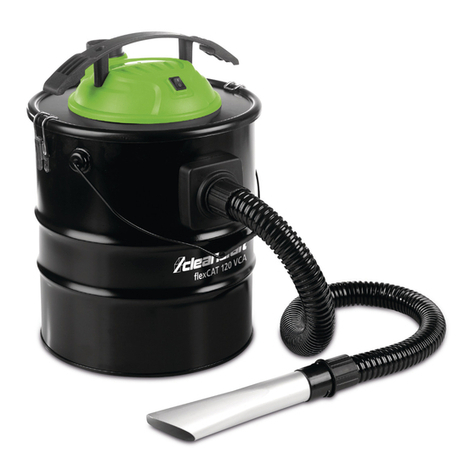
CleanCraft
CleanCraft flexCAT 120 VCA User manual
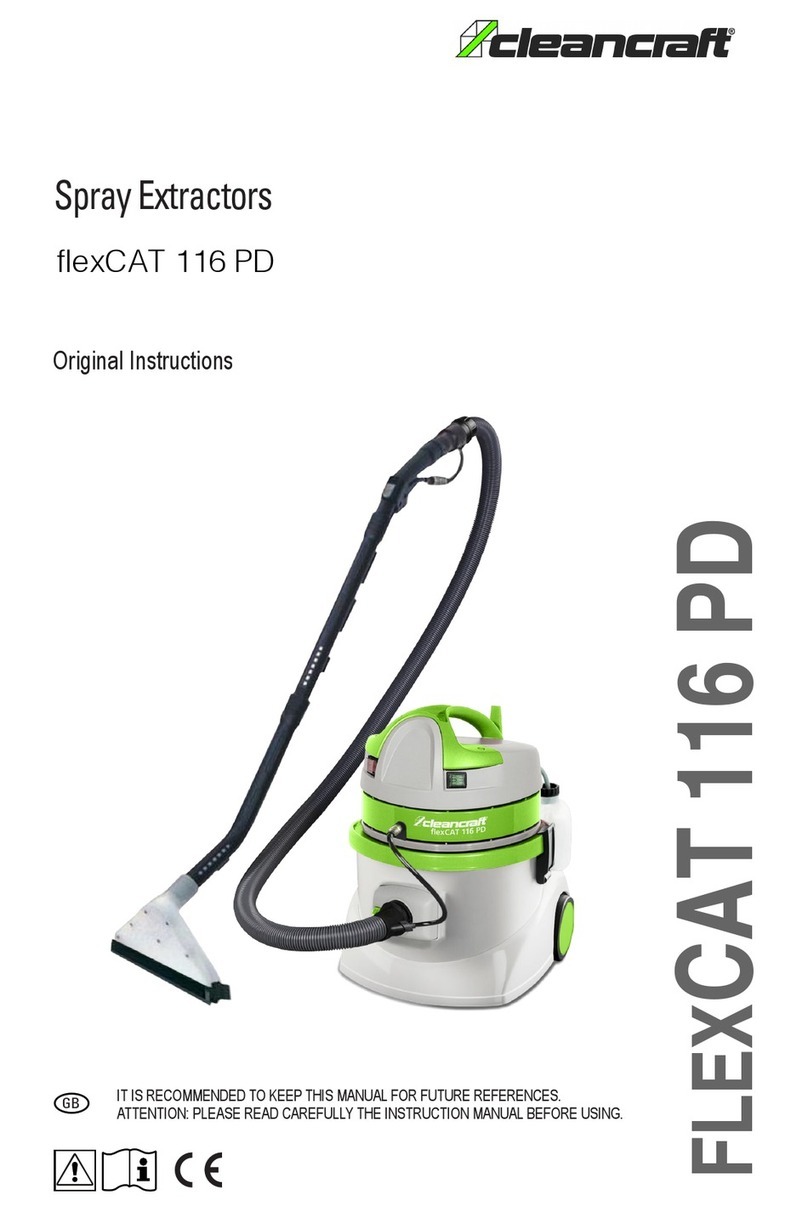
CleanCraft
CleanCraft flexCAT 116 PD User manual
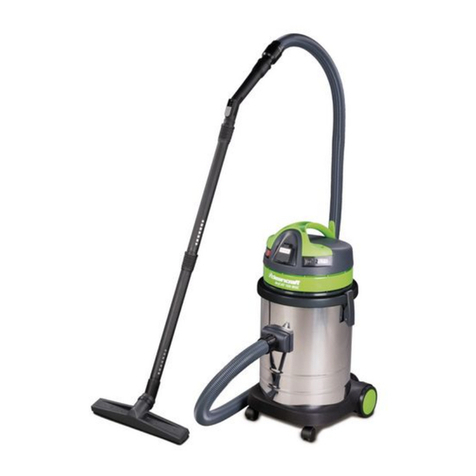
CleanCraft
CleanCraft dryCAT Series User manual
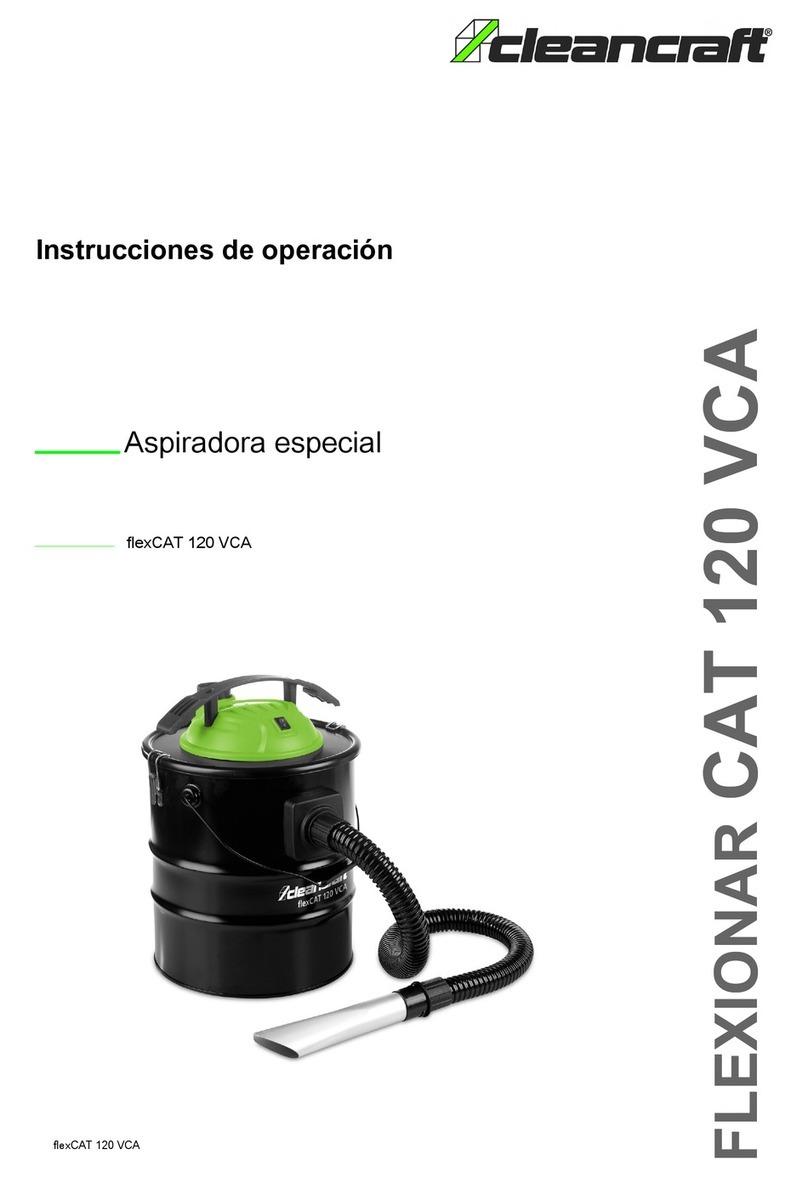
CleanCraft
CleanCraft flexCAT 120 VCA User manual
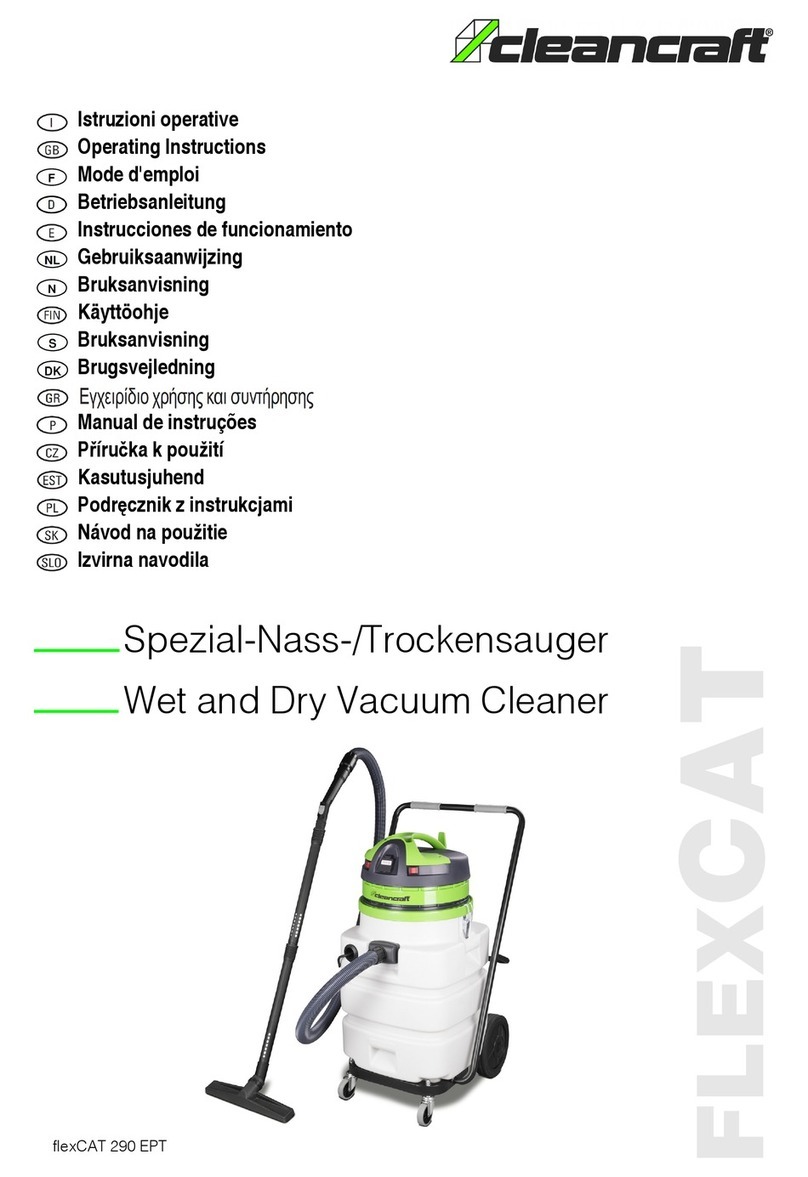
CleanCraft
CleanCraft flexCAT 290 EPT User manual

CleanCraft
CleanCraft VCA Series User manual
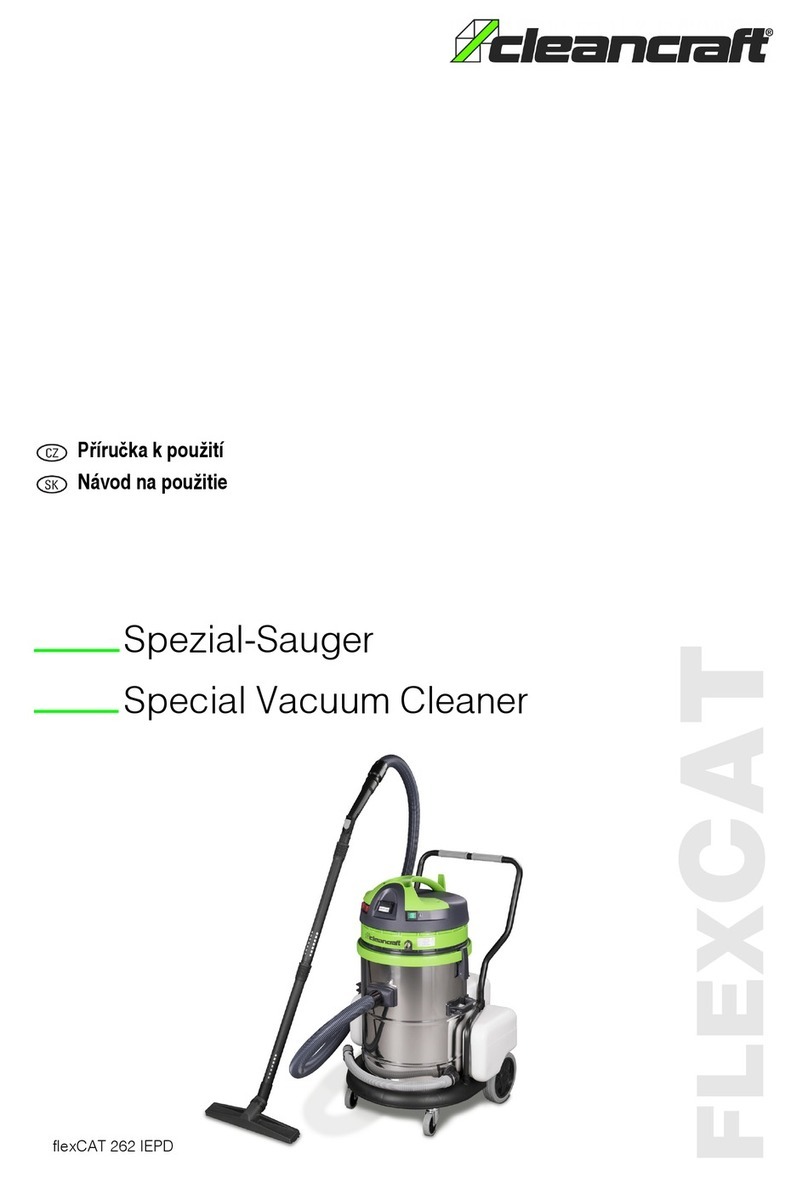
CleanCraft
CleanCraft flexCAT 262 IEPD User manual
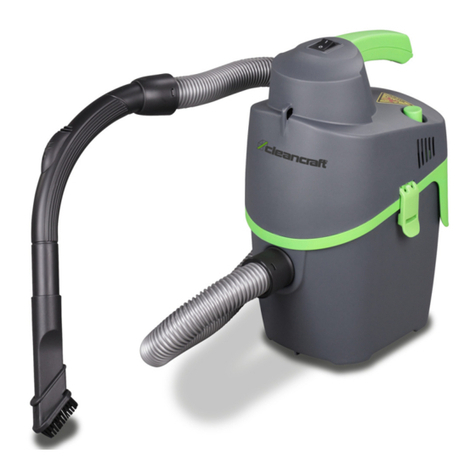
CleanCraft
CleanCraft flexCAT 16 H User manual
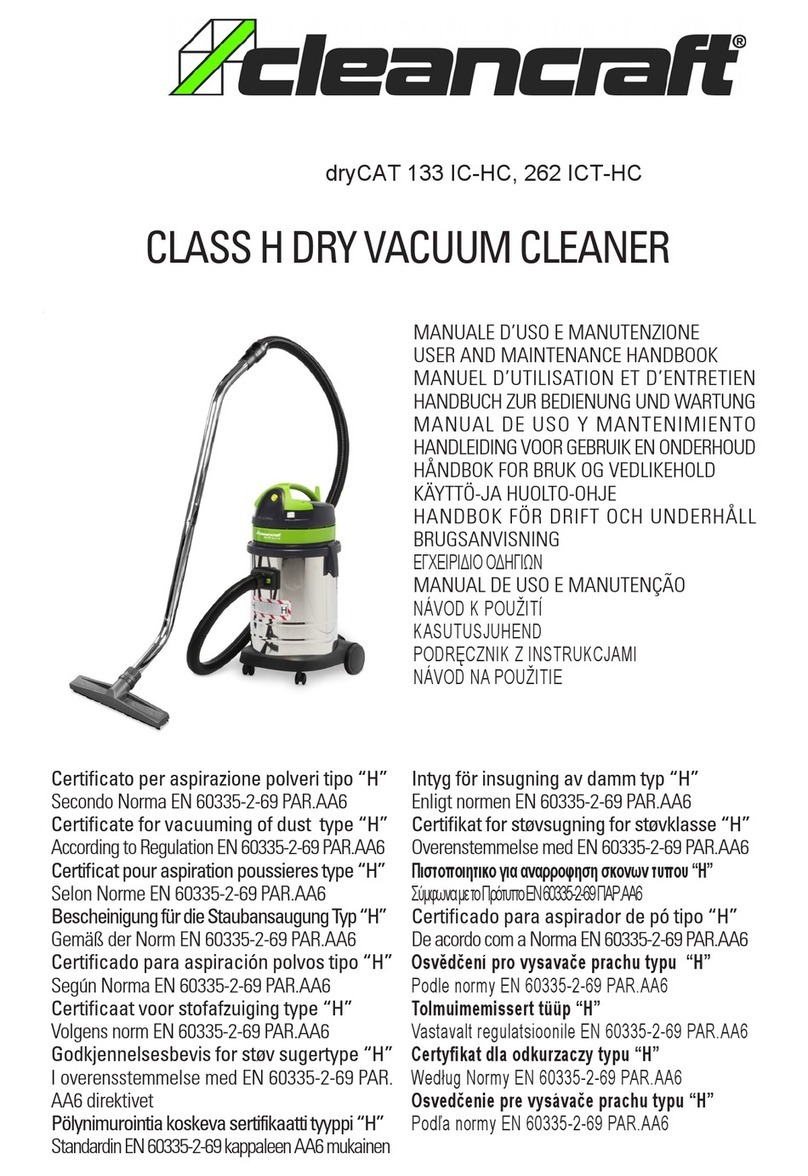
CleanCraft
CleanCraft dryCAT 133 IC-HC Manual

CleanCraft
CleanCraft flexCAT Series User manual
